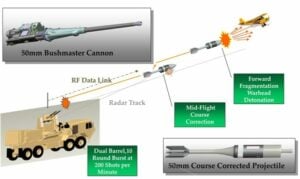 The US Army has announced that it has successfully demonstrated its latest counter-UAV (unmanned aerial vehicle) technology, shooting down two unmanned aircraft as part of their demonstration. Although the research project began with the objective to counter rockets, artillery and mortars, the project scope was expanded to include unmanned aerial threats.
The US Army has announced that it has successfully demonstrated its latest counter-UAV (unmanned aerial vehicle) technology, shooting down two unmanned aircraft as part of their demonstration. Although the research project began with the objective to counter rockets, artillery and mortars, the project scope was expanded to include unmanned aerial threats.
“Every country has drones now, whether they are armed or not or what level of performance. This is a huge threat that has been coming up on everybody. It has kind of almost sneaked up on people, and it’s almost more important than the counter-RAM threat,” said Manfredi Luciano, project officer for the Enhanced Area Protection and Survivability, or EAPS, Army Technology Objective. The technology is being developed by the U.S. Army Research, Development and Engineering Center, or ARDEC, at Picatinny Arsenal. Funding for development and testing was provided by the ARDEC Technology Office.
The challenge has grown exponentially in the last decade as the world’s inventory of unmanned aircraft systems has grown from approximately 20 system types and 800 aircraft in 1999, to more than 200 system types and approximately 10,000 unmanned aircraft in 2010, according to Nancy Elliott, a spokeswoman with the U.S. Army’s Fires Center of Excellence on Fort Sill, Oklahoma.
Although a missile-based Counter Rocket, Artillery, and Mortar, or C-RAM, defense system has been selected as the technical approach for the Indirect Fire Protection Capability Increment 2 Intercept Program of Record, the gun alternative continued to mature as force-protection technologies for other potential applications.
During the final testing at Yuma Proving Ground, Arizona, engineers shot down two class 2 UAVs using command guidance and command warhead detonation. The UAV was an outlaw-class aircraft, a product of Griffon Aerospace, and the intercept engagements occurred at ranges of a kilometer and around 1500 metres.
The first shoot-down at the kilometer range was a replication of a previous test, in which the EAPS technology first successfully intercepted a loitering UAV. Some fire-control improvements were made after these previous tests, and were validated during the second testing. The second shoot-down was executed at a 50 percent greater range and exceeded the EAPS demonstration objectives.
The EAPS ARDEC gun alternative to area protection envisions a 50mm cannon to launch command guided interceptors. The system uses a precision tracking radar interferometer as a sensor, a fire control computer, and a radio frequency transmitter and receiver to launch the projectile into an engagement “basket.”
“In order to minimize the electronics on board the interceptor and to make it cheaper, all the ‘smarts’ are basically done on the ground station,” Luciano said. “The computations are done on the ground, and the radio frequency sends the information up to the round.”
The Picatinny area-protection system tracks both the incoming threat and interceptor, then computes an ideal trajectory correction for the interceptor to maximize probability of mission success. A thruster on the interceptor/projectile is used for course correction. The ground station uplinks the maneuver and detonation commands, while receiving downlinked assessment data.
The interceptor takes the commands and computes the roll orientation and time to execute thruster and warhead detonation. The warhead has a tantalum-tungsten alloy liner to form forward propelled penetrators for defeat of C-RAM targets, and steel body fragments to counter unmanned aerial systems. C-RAM stands for counter rockets, artillery and mortars.
The integrated test demonstrated a proof-of-principle that direct fire, command guided ammunition can intercept and negate aerial threats, Luciano said. Technologies from the EAPS gun alternative Army Technology Objective, or ATO, may potentially be used for both Army and Navy air defense systems, he added.
The testing concludes the EAPS Gun ATO. ARDEC now awaits counter-UAV requirements. Once requirements are generated and approved, the technologies developed under EAPS can be configured to a new design for a future tactical system.
The EAPS fire-control radar interferometer was designed, fabricated, and operated by Technovative Applications in Brea, California. Radar interferometers use multiple receive antennas to enhance angular measurements for centimeter tracking accuracy.
Design of the 50mm cartridge/interceptor was a collaborative effort between ARDEC engineers and Orbital ATK, Armament Systems Division in Plymouth, Minnesota. Interceptors were assembled by Orbital ATK and warheads by Aerojet Rocketdyne in Sacramento, California. The fire-control algorithm was a collaborative effort by the various subject matter experts but led and written by Propagation Research Associates, Inc., in Atlanta.
The EAPS Integrated Product Team was led by ARDEC’s Munitions Systems and Technology Directorate at Picatinny Arsenal.


















